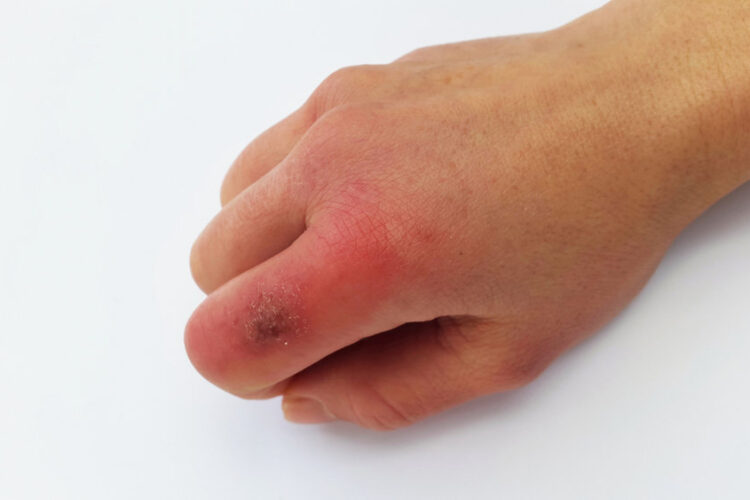In the winter season, the cold and humidity come together to attack the skin, causing a weakening and loss of its hydrolipidic barrier. In addition, these climatic conditions cause an annoying and painful condition called pernio erythema or perniosis, better known as chilblains.
The parts most affected by chilblains are usually the feet, nose, ears, and hands, as they are areas where blood vessels end, where circulation is scarcer.
As it is a source of concern for everyone, especially when the cold season approaches, this post is dedicated to explaining the causes and symptoms of chilblains, the preventive measures to avoid them, and the treatment to cure them.
Why do chilblains occur?
Although the exact cause of the appearance of chilblains is not known for sure, it is generally attributed to climatic factors, such as sudden changes from cold to heat or prolonged exposure to low temperatures.
Other causes that can cause pernio erythema could include:
- Circulatory system diseases.
- Autoimmune or connective tissue pathologies, such as lupus erythematosus.
- Women are more likely to develop this injury.
- Alcoholism, smoking, and malnutrition.
- Wear open shoes in winter.
Risk factors for getting chilblains
The Official College of Podiatrists of Castilla-La Mancha includes the following among the factors that increase the risk of having chilblains:
- Having poor blood circulation.
- Suffer from rheumatoid arthritis.
- suffer from vasculitis
- Have Raynaud’s disease.
- Older adults, due to sedentary lifestyle and little mobility.
- Hormonal changes in women.
- Bodyweight below the corresponding.
- Abuse of alcoholic beverages.
- Have cryoglobulinemia, a rare disease in which antibodies have been produced that precipitate with low temperatures.
Symptoms of chilblains
Chilblains are skin lesions that can be detected with the naked eye, and although they usually disappear on their own, it is best to go to a doctor to confirm the diagnosis.
On the other hand, the Catalan Foot Institute says that “the symptoms begin with a burning and tingling sensation giving way to significant itching or itching.”
It could be said that its most common symptoms are:
- Redness of the area in the hands, feet, or ears can turn purple over the days.
- Moderate swelling, which in the case of the feet, can make wearing shoes very uncomfortable.
- Tingling and burning sensation.
- Sometimes sharp pain can occur.
- The appearance of blisters or ulcers in the affected area.
- Patients may suffer from atrophic sequelae and deformities in the most severe cases.
How to treat chilblains?
Treatment of chilblains includes basic measures that can be done at home to mitigate their effects until they disappear. Some of them are:
- Gently rewarm the affected skin without massaging, rubbing, or direct heat.
- Avoid exposure to cold. Apply lotion to relieve itching.
- Stop smoking because this can constrict blood vessels and slow wound healing.
These recommendations are those that podiatry experts generally give to treat these injuries.
If the problem persists, they must be treated internally, so it is time to resort to medical help and the drugs they prescribe.
What medications to use to treat chilblains?
In this sense, medication to treat chilblains aims to improve the patient’s blood circulation with treatments that favor the dilation of blood vessels. In addition, as one of the complications of chilblains is the appearance of blisters and ulcers on the skin that can become infected, this dangerous symptom must also be attacked.
Pharmacological treatments applied in these cases are:
- A topical corticosteroid . Using a corticosteroid cream on chilblains may help the lesions to disappear.
- Gels and ointments. These ointments and gels can help relieve the pain, itching, and burning caused by chilblains.
- Nifedipine (Procardia). This class of blood pressure medications allows blood vessels to dilate and improve circulation.
How to avoid chilblains?
For people who have the factors that predispose them to chilblains, it can be tough to avoid them. However, some tips are handy both for them and the general population.
- Avoid exposure to cold.
- Do not expose your hands or feet directly to the stove or radiator.
- Wear loose clothing that does not compress circulation and retains body heat.
- Wear gloves and run away from the wind.
- Wear waterproof shoes and cotton socks to avoid the cold.
- Perform physical exercise regularly.
- Give up tobacco completely.
- Massage the prone areas to stimulate blood flow.
- Apply moisturizing creams to mitigate dry skin.
Although with the arrival of winter, the risk of contracting annoying chilblains increases, a set of measures can be adopted that reduce the possibility of suffering from them. With care and prevention, you can beat the child!


